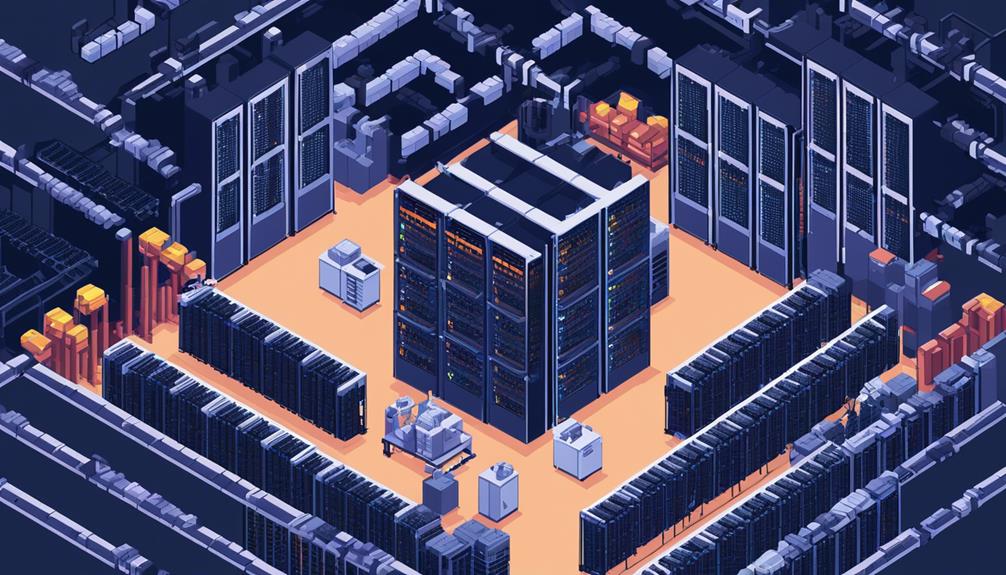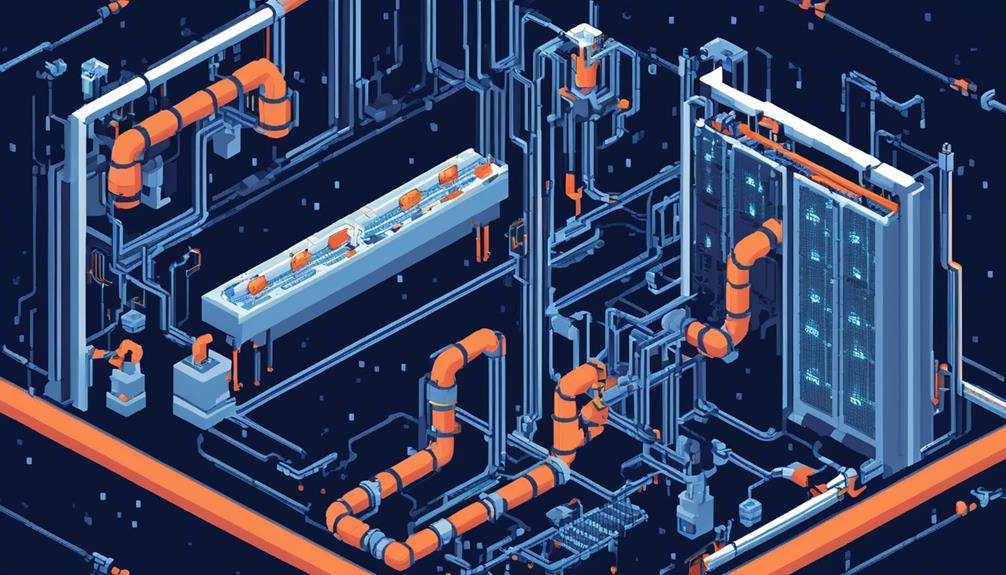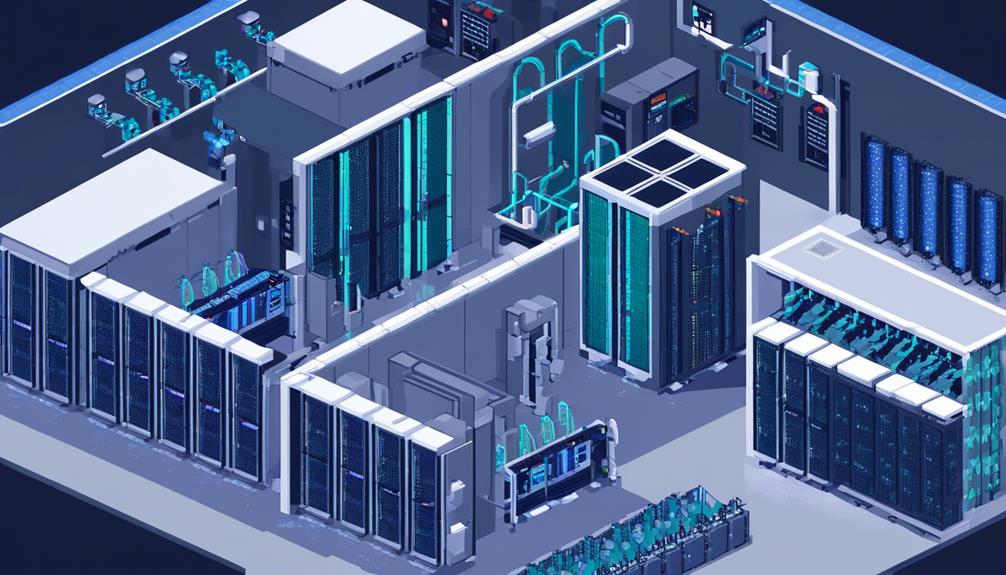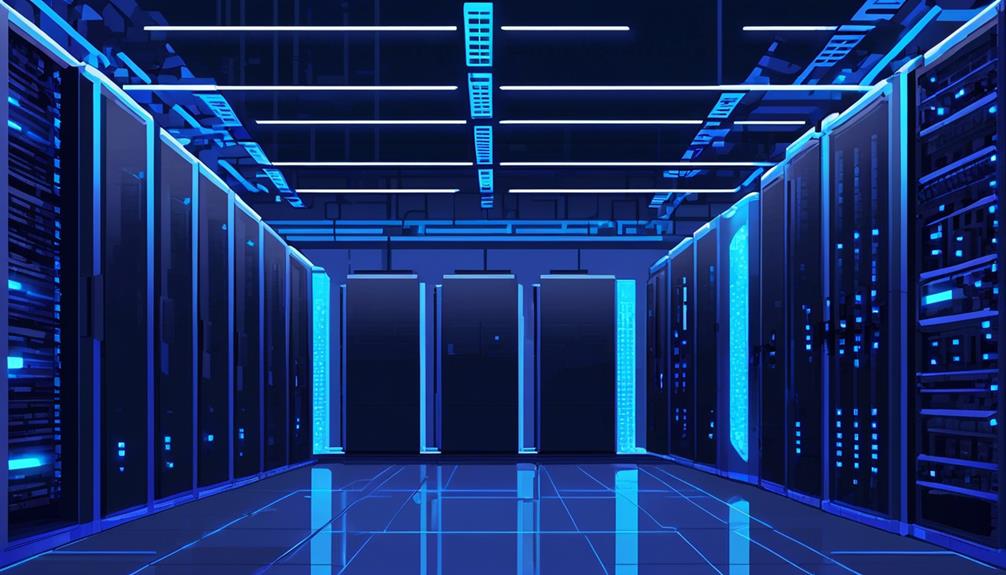Data center cooling systems play a critical role in maintaining a stable and controlled environment for data centers. With the increasing demand for data storage and processing, it is imperative to ensure optimal temperatures and humidity levels to prevent equipment failure and ensure the reliability of IT equipment. These systems are designed to efficiently remove the excess heat generated by the high power usage of the data center and replace it with cooler air.
While various methods and technologies, such as air cooling, liquid cooling, and emerging techniques like geothermal cooling and evaporative cooling, are used, finding the most efficient and cost-effective cooling solution remains a challenge.
In this discussion, we will explore the different cooling systems employed in data centers, their advantages and limitations, and the potential for innovative approaches to enhance energy efficiency and reduce operational costs.
Key Takeaways
- Air cooling systems and liquid cooling methods are both effective strategies for dissipating heat in data centers.
- Hot and cold aisle layouts improve cooling efficiency and prevent equipment overheating.
- Natural cooling techniques, such as utilizing outside air or geothermal cooling, can be cost-effective and environmentally-friendly options.
- Smart technology, including sensors, monitoring systems, and automation, can optimize cooling systems, improve energy efficiency, and reduce environmental impact.
Air Cooling Systems

Air cooling systems, utilizing the circulation of cool air, are an effective and cost-efficient method for dissipating heat from data center equipment. These systems are commonly used in data centers to maintain optimal temperatures and prevent heat-related equipment failures. Air cooling relies on the principles of convection and uses fans, air ducts, and vents to facilitate the movement of cool air and expel hot air.
Data centers typically employ the concept of cold aisles and hot aisles to optimize cooling efficiency. Cold aisles are where the cool air is supplied, while hot aisles are where the hot air is exhausted. This layout helps to isolate the hot air and prevents it from mixing with the cool air, maximizing the cooling efficiency of the air cooling system.
To achieve effective air cooling, data centers need to have a well-designed cooling infrastructure. This includes proper placement of air conditioning units, air ducts, and vents to ensure the even distribution of cool air throughout the facility. The ambient air temperature also plays a crucial role in air cooling efficiency. By monitoring and controlling the ambient air temperature, data center operators can optimize cooling performance and reduce energy consumption.
Regular maintenance and monitoring of air cooling systems are essential to ensure their efficiency and longevity. This includes cleaning air filters, inspecting fans and vents for any blockages, and monitoring temperature and humidity levels. By maintaining proper airflow and ensuring the cleanliness of the cooling equipment, data centers can maximize the cooling efficiency of their air cooling systems.
Hot and Cold Aisle Layouts
In order to optimize cooling efficiency and prevent equipment overheating, data centers employ hot and cold aisle layouts, segregating hot and cold air streams within the facility. This technique plays a crucial role in maintaining optimal temperature ranges and ensuring the smooth operation of data centers.
Here are some important facts about hot and cold aisle layouts:
- Hot Aisle Layout: In this layout, server racks face each other, expelling hot air into the same aisle. The hot air is then directed towards the cooling systems for heat removal. This arrangement prevents the mixing of hot and cold air, reducing the chances of equipment overheating.
- Cold Aisle Layout: In contrast, in the cold aisle layout, server racks face away from each other, drawing in cool air from the same aisle. The cool air is then directed towards the server intakes, ensuring that the equipment receives sufficient cooling for optimal performance.
- Improved Cooling Efficiency: By segregating hot and cold air streams, hot and cold aisle layouts promote proper airflow management. This helps prevent the formation of hot spots and improves the overall effectiveness of the cooling systems.
- Energy Efficiency: Hot and cold aisle layouts contribute to energy cost reduction in data centers. By containing hot exhaust air and directing cool airflow to the server intakes, these layouts minimize the workload of air conditioners, leading to lower energy consumption.
Implementing hot and cold aisle layouts is essential for maintaining the desired temperature ranges and preventing equipment overheating in data centers. These cooling techniques, along with other cooling solutions such as liquid cooling systems, play a vital role in ensuring the efficient operation of data centers while minimizing energy costs.
Liquid Cooling Methods

Liquid cooling methods are an innovative and efficient solution employed in data centers to effectively remove heat from IT equipment by utilizing a liquid medium such as water or coolants. These cooling methods have gained popularity in recent years due to their ability to reduce cooling costs and provide targeted cooling to high-density computing environments.
One type of liquid cooling technology is liquid immersion cooling, which involves submerging the IT equipment in a non-conductive liquid coolant. This method allows for more efficient heat dissipation as the coolant can directly absorb the heat generated by the equipment. Liquid immersion cooling is particularly beneficial for data center professionals dealing with high-performance computing (HPC) systems, as it can significantly lower cooling costs and improve energy efficiency.
Another liquid cooling method is direct-to-chip cooling, where a liquid coolant is directly applied to the surface of the chips. This approach offers enhanced cooling performance by directly targeting the heat-generating components. It is commonly used in servers and high-end computing systems where traditional air cooling methods may not be sufficient.
Rear door heat exchangers are also utilized in liquid cooling systems. These devices are attached to the back of server racks and employ liquid coolant that runs through them to absorb heat from the exhaust air. The heated coolant is then cooled through a heat exchange process, allowing it to be reused to cool the IT equipment.
Natural Cooling Techniques
As we shift our focus to natural cooling techniques, we explore innovative methods that harness the surrounding environment to effectively lower data center temperatures, offering a sustainable and cost-effective solution to data center cooling.
- Utilizing outside air: One approach is to use outside air to cool the data center. By implementing a system that takes advantage of favorable outdoor temperatures, the need for mechanical cooling can be significantly reduced. This method, known as free cooling, can save a substantial amount of energy and operational costs.
- Leveraging bodies of water: Another natural cooling technique involves utilizing bodies of water for heat exchange. Cold water from a nearby river or lake can be pumped through the data center to remove heat generated by the equipment. This not only helps in cooling the data center but also conserves energy as it eliminates the need for traditional cooling systems.
- Geothermal cooling: Geothermal cooling takes advantage of the constant temperature of the ground to cool the data center. Pipes are installed underground to circulate chilled water, which is then used to remove heat from the servers. This method is highly efficient and can provide consistent cooling throughout the year.
- In-row cooling units: In-row cooling units are placed directly between server racks, offering localized cooling and reducing the need for extensive airflow management. These units provide precise temperature control, resulting in improved energy efficiency and reduced cooling requirements.
Implementing natural cooling techniques requires careful monitoring and management of the data center environment. Factors such as local climate, humidity levels, and environmental impact must be considered to ensure optimal performance and reliability.
Smart Technology for Data Center Cooling

Utilizing advanced AI and machine learning, smart technology for data center cooling revolutionizes the monitoring and management of cooling systems, optimizing energy efficiency and reducing environmental impact. This newer data center cooling approach goes beyond traditional data center cooling technologies, aiming to improve data center performance while minimizing energy consumption.
One of the key challenges in data center cooling is the issue of cold air mixing, which can lead to inefficiencies and hot spots. Smart technology addresses this by utilizing AI algorithms to analyze temperature data, airflow patterns, and heat distribution within the data center. By dynamically adjusting the cooling infrastructure, such as computer room air conditioning (CRAC) units, smart technology ensures optimal cooling in real-time.
Next-generation data center cooling systems are also exploring innovative techniques such as vectored cooling. This technique involves directing cool air precisely to where it is needed, reducing wasteful airflow and improving cooling efficiency. By leveraging AI and machine learning, these systems can continuously optimize cooling operations, ensuring that cooling resources are utilized effectively.
Furthermore, smart technology for data center cooling is exploring the use of nature-inspired solutions, such as geothermal and evaporative cooling. Geothermal cooling utilizes the stable temperature of the earth to cool the data center, while evaporative cooling harnesses the cooling effect of water to cool the air. These sustainable cooling methods not only reduce energy consumption but also minimize the environmental impact of data center operations.
Frequently Asked Questions
What Is the Cooling System Used in Data Centers?
Liquid cooling solutions are commonly used in data centers for their efficiency and ability to handle high-density computing loads. These systems utilize liquid to absorb and dissipate heat from the servers, resulting in more effective cooling compared to traditional air-based systems.
Energy efficient cooling options, such as free cooling and geothermal cooling, are also gaining popularity due to their reduced environmental impact and cost savings.
Cooling system scalability, redundancy, maintenance best practices, and integration with server racks are essential considerations for ensuring optimal performance and reliability.
Advanced airflow management techniques, automation, and smart controls further enhance the overall cooling system efficiency and effectiveness.
What Is the Best Cooling for Data Centers?
Energy efficient cooling solutions are crucial for data centers, especially in high density environments. Liquid cooling technologies have emerged as one of the best options, offering efficient heat dissipation for high-powered servers.
The impact of cooling on data center efficiency cannot be overstated, as it directly affects operational costs and equipment lifespan. Innovations in data center cooling include geothermal and evaporative cooling, while smart technologies like AI and machine learning enable better monitoring and management.
Proper airflow management, cooling system maintenance, and optimization are essential for large scale and remote/edge data centers.
Future trends in data center cooling technologies focus on sustainability, such as utilizing renewable energy sources and exploring advanced cooling techniques.
What Is the Most Common HVAC System Used in Data Centers?
The most common HVAC system used in data centers is the precision air conditioning (PAC) system. PAC systems are designed to maintain stable and optimal environmental conditions for sensitive data center equipment. These systems use a combination of cooling methods, such as direct expansion (DX) cooling, chilled water cooling, or a combination of both.
They are crucial for preventing equipment failure and ensuring consistent performance in data centers. PAC systems are engineered to provide precise and reliable cooling to meet the demanding requirements of modern data center environments.
How Do You Cool Down a Data Center?
To cool down a data center, it is crucial to employ energy efficient cooling techniques and address the cooling challenges faced in large scale data centers.
Innovative cooling solutions such as liquid cooling play a significant role in maintaining optimal temperature and humidity levels.
Additionally, thermal management strategies for data center infrastructure, optimizing airflow for efficient cooling, and considering cooling technologies for cloud-based and modular data center designs are essential to ensure the overall performance and reliability of the data center.

